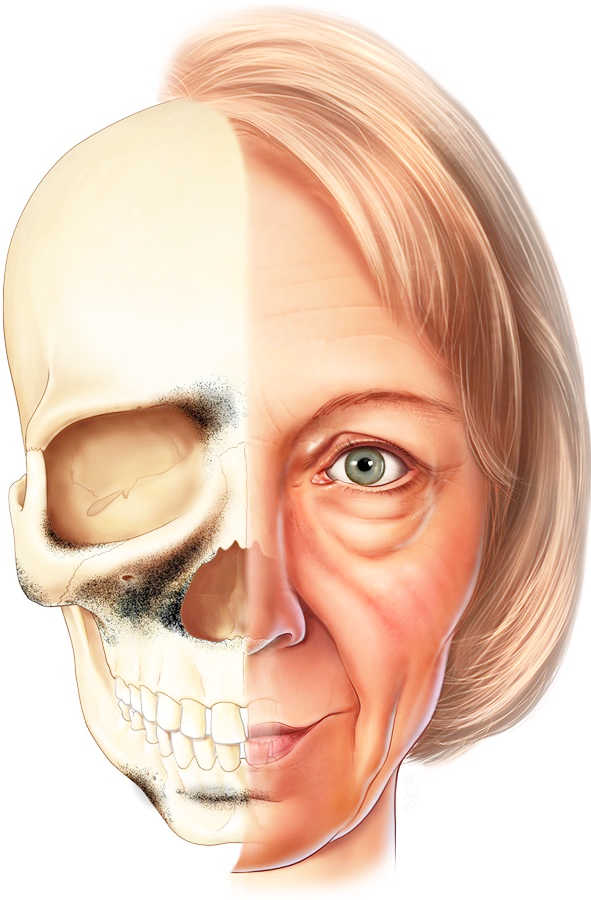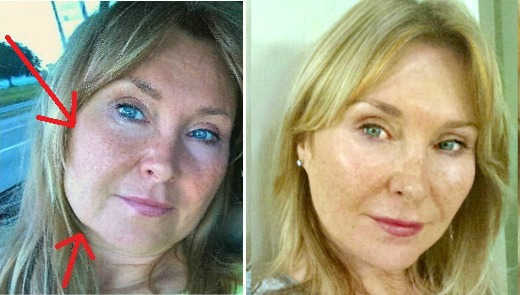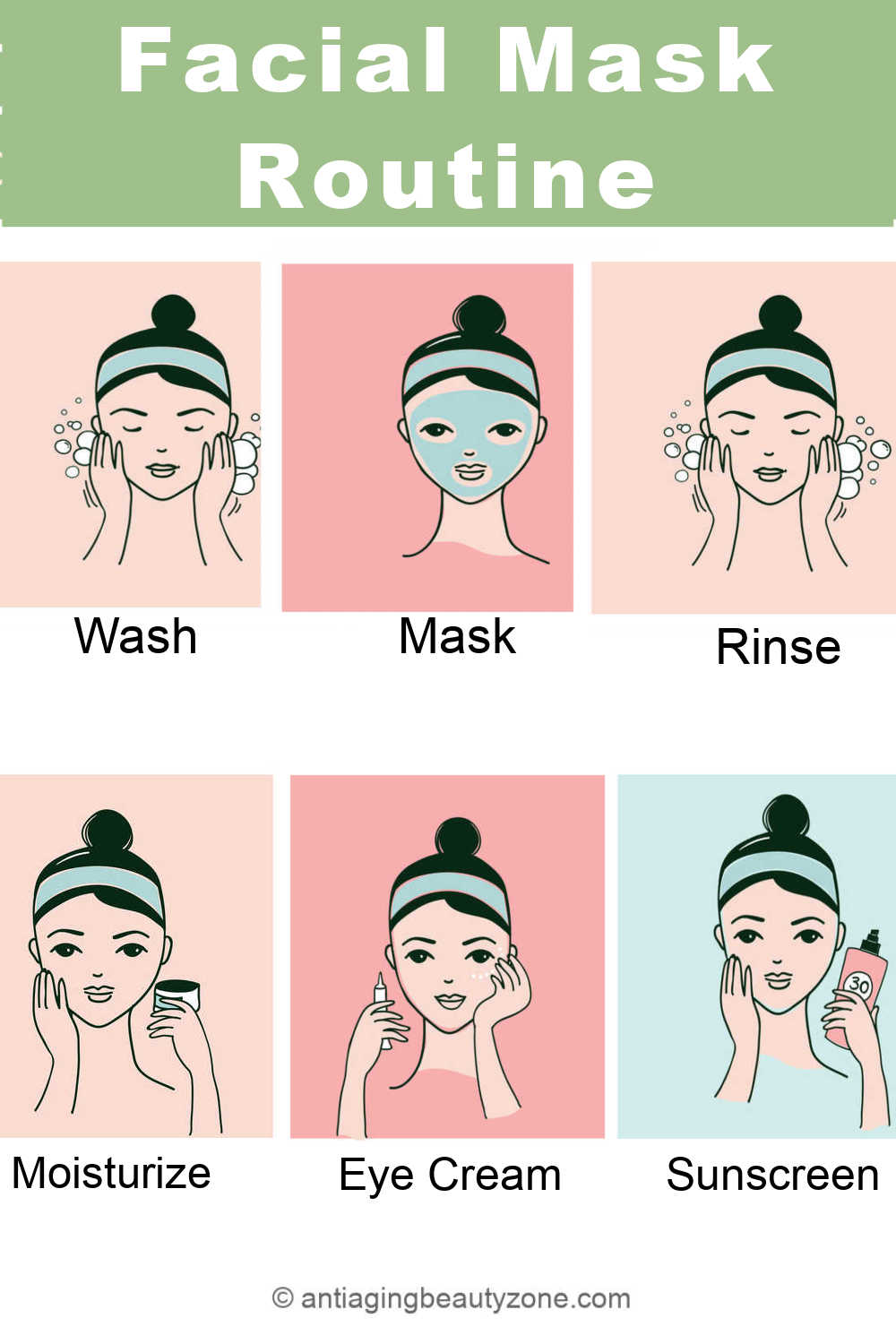- Home
- Face
I may earn from qualified Amazon & Affiliate purchases at no cost to you.
Firm Your Sagging Face Naturally: Inexpensive Tips for Jowls, Cheeks, and Radiant Skin
by: Linda Robison / Facial Fitness Specialist @ ABZ
A sagging face can make your skin appear dull, lifeless, and older than you feel. Lost skin elasticity and weakened facial muscles contribute to this common concern. But don't worry, there are natural and effective ways to lift, tighten, and rejuvenate your appearance.
This ABZ guide explores proven facial exercises, targeted skincare routines, and expert tips to help you achieve a firmer, more youthful-looking face.
Understand a sagging face
 Darkened areas show where the greatest bone loss occurs. (Image credit: Aesthetic Plastic Surgery, Bryan Mendelson and Chin-Ho Wong)
Darkened areas show where the greatest bone loss occurs. (Image credit: Aesthetic Plastic Surgery, Bryan Mendelson and Chin-Ho Wong)How aging causes a sagging face
Did you know your face changes shape as you age? Here's what happens:
- Bone Shrinkage: The facial bones lose volume, reducing the support they provide to your skin and soft tissues.
- Fat Shifting: Fat pads in your face shrink and move, creating hollows in some areas while causing sagging in others.
- Loss of Elasticity: Collagen and elastin, the proteins that keep skin firm and bouncy, gradually break down over time.
These changes often lead to sagging cheeks, jowls, and double chins. Starting facial exercises early can help counteract these effects, naturally lifting and tightening the lower face.
The power of facial exercises
Facial exercises offer a natural, non-invasive way to combat sagging skin. By targeting and strengthening the underlying facial muscles, you can:
- Lift and Tighten Skin: Stronger muscles provide better support for the skin, reducing sagging in the cheeks, jowls, and neck.
- Improve Facial Contours: Defined facial muscles create a more sculpted and youthful appearance.
- Boost Circulation: Increased blood flow delivers essential nutrients and oxygen to the skin, promoting a healthy glow.
- Stimulate Collagen Production: Regular exercise can help boost collagen and elastin, further improving skin firmness and elasticity.
Face exercises can strengthen underlying facial muscles, supporting the skin and preventing sagging.
A study in JAMA Dermatology found that 20 weeks of facial exercises significantly improved facial contours, leading to a firmer, more youthful appearance. Patience and consistency are crucial—results can take months to become noticeable.
 Firmer Face before and after Face Exercise
Firmer Face before and after Face ExerciseIn my experience, the most dramatic changes occurred between 6 to 9 months, especially around my neck and jawline. With dedication, a natural, non-surgical face lift effect is achievable.
Note: Within a few months of starting facial exercises, I not only noticed my jawline appeared more defined, but my sagging neck was visibly firmer.
Choosing the right exercise program for droopy skin
Not all facial exercise programs are created equal. An effective program should:
Target All Major Facial Muscles: A comprehensive approach ensures balanced results and prevents an overdeveloped look in certain areas
Incorporate Massage Techniques: Massage stimulates circulation and collagen production, enhancing the benefits of exercise.
Be Easy to Follow: A simple routine encourages consistency, which is key to achieving long-term results.
Sagging Face: Before and after results
What Does a Sagging Face Look Like?
A sagging face is characterized by droopy cheeks, jowls, and dull skin. This can make the face appear bottom-heavy and aged.
Consistent facial exercises can reduce sagging in the mid and lower face. In my experience, they not only lifted my cheeks but also boosted my skin’s radiance for a natural glow.
 My Before and After results over 10 years later.
My Before and After results over 10 years later.Before Facial Exercises: My skin looked dull despite regular exfoliation and expensive skincare treatments.
After Facial Exercises: Strengthened muscles created a smoother surface, allowing light to reflect more evenly for a radiant complexion.
Studies show that facial exercises can improve skin function by reducing wrinkles and sagging.
Although studies are limited and researchers admit they're not sure how or why it works.
How do facial exercises work? The science behind firmer skin
Facial exercises strengthen the muscles that support your skin, helping to lift areas prone to sagging like the cheeks, jawline, and neck. By toning these muscles, they create a firmer foundation, reducing drooping and giving your face a more youthful, sculpted look.
These exercises also boost circulation, which can improve skin elasticity over time. With regular practice, facial exercises are a natural way to fight sagging and keep your face looking lifted and refreshed.
Facial exercises work by toning these muscles, providing natural support for the skin and enhancing its appearance without invasive procedures.
Facial exercises rejuvenate sagging skin by:
- Muscle Toning for Smoother Skin: Firm muscles tighten the overlying skin, reducing wrinkles and sagging.
- Improved Blood Flow: Exercise enhances circulation, promoting a healthy glow and reducing dullness.
- Collagen and Elastin Boost: Regular exercise helps maintain these essential proteins, keeping skin elastic and youthful.
By keeping your facial muscles active, you can enjoy a non-surgical face lift effect, improving facial contours and skin tone naturally over time.
Maximize your results: Skincare and solutions for sagging skin
Facial exercises can work wonders, but combining them with a solid skincare routine and other targeted solutions takes your results to the next level. Here's how to naturally support firmer, healthier skin while exploring additional options.
Skincare Essentials for Tightening Sagging Skin:
- Hydrate and Nourish: Keep your skin moisturized with a pH-balanced, fragrance-free moisturizer to maintain elasticity and a healthy barrier.
- Exfoliate Smartly: Gentle exfoliation removes dead skin, allowing active ingredients to penetrate better and rejuvenate your skin.
- Focus on Collagen Boosters: Products with active ingredients like retinol, peptides, and hyaluronic acid can help rebuild your skin’s firmness:
- Retinol: Encourages collagen production and speeds up skin cell turnover.
- Hyaluronic Acid: Deeply hydrates and plumps sagging skin.
- Peptides: Strengthen collagen and elastin for added firmness.
Additional solutions for loose skin:
- Facial Massage: Regular massages improve blood flow and stimulate lymphatic drainage, reducing puffiness and enhancing skin tone. Pair with a hydrating serum for extra glide and nourishment.
- Dermarolling or Microneedling: These at-home tools can boost collagen production and help improve skin texture when used correctly.
- Face Masks: Look for facial masks infused with tightening agents like clay, caffeine, or marine extracts to temporarily firm the skin.
Effective exercises for loose facial skin
The chart below shows all the muscles used while during the workout. In the first 6–12 months it's recommend you do the workout about 3 times - which takes less than 15 minutes a session.
Once you've achieved your goals, you can cut down to a few times a month for maintenance.

 Courtesy of Carolyn's Facial Fitness, LLC
Courtesy of Carolyn's Facial Fitness, LLCSagging jowls
Sagging jowls along the jawline are a common aging concern. They can make you look older and contribute to a less defined facial contour. While surgery is an option, many people prefer a more natural approach.
If you're looking to lift and tighten sagging jowls without the risks and expense of surgery, targeted facial exercises can be an effective solution.
Learn more about this effective jowl exercises and how they can help you achieve a firmer, more youthful jawline.
FAQ: How to Firm a Sagging Face
Q:What causes face sagging?
Q:What causes face sagging?
A: Many factors contribute to facial sagging, but the most important are:
- loss of collagen
- loss of and redistribution of facial fat
- loss of and reabsorption of facial bone mass
The facial fat that once sat high in the cheek area is reduced, and this causes the skin to sag downward. Picture a balloon with some air let out.
Facial bone changes cause the skin to droop too, especially around the eyes and jaw bone area. See this picture on how facial bone change with age.
Eventually, these change affect the shape of our face. The face tends to get bottom-heavy (i.e., droopy cheeks, jowls, and double chin) as time goes on.
Q: Some massage therapists like to use a jade stone roller as a form of massage. Which face rollers do you suggest for a sagging face?
Q: Some massage therapists like to use a jade stone roller as a form of massage. Which face rollers do you suggest for a sagging face?
A: Personally, I like to use my hands. The index finger, middle finger, and ring finger provide enough gentle pressure to stimulate lymph nodes, massage face muscles and is a great way to relax and reduce a lot of tension in the face and neck. For best results, make circular motions using firm pressure. Start at your jowls and massage in an upward direction along the sides of your face. Make sure to apply a little face cream or face serum, so you're not tugging on the skin. Click here to see a video of the Sagging Skin Face Massage.
Q: What causes face sagging?
Q: What causes face sagging?
A: Many factors contribute to facial sagging, but the most important are:
- loss of collagen
- loss of and redistribution of facial fat
- loss of and reabsorption of facial bone mass
The facial fat that once sat high in the cheek area is reduced, and this causes the skin to sag downward. Picture a balloon with some air let out.
Facial bone changes cause the skin to droop too, especially around the eyes and jaw bone area. See this picture on how facial bone change with age.
Eventually, these change affect the shape of our face. The face tends to get bottom-heavy (i.e., droopy cheeks, jowls, and double chin) as time goes on.
Q: How does facial massage help sagging skin?
Q: How does facial massage help sagging skin?
A: A face massage helps increase blood flow and helps stimulate fibroblast cells, improve connecting tissues and increase collagen and elastin... All necessary for healthy, firm skin tone. We're not talking about results like a facelift, but regular facial massages helps keep good skin tone and lessen age related sagging.
Q: How does a jade roller or gua sha stone help firm up facial skin?
Q: How does a jade roller or gua sha stone help firm up facial skin?
A: These devices can help improve and drain the lymphatic system. As we get older, our faces tend to hold more fluid around the lower half of our face, making our faces look saggy and bloated. A regular facial massage can help slim and contour the face and neck area - giving you a firmer look
Q: Does Botox help with sagging cheeks?
Q: Does Botox help with sagging cheeks?
A: Botox is not typically used to address sagging cheeks. Botox (Botulinum toxin) is a neurotoxin that is commonly used for cosmetic purposes to reduce the appearance of wrinkles and fine lines by temporarily paralyzing specific facial muscles. It is commonly used for areas such as the forehead, between the eyebrows (glabellar lines), and around the eyes (crow's feet).
Sagging cheeks, on the other hand, are usually caused by a loss of skin elasticity and volume, which occurs naturally with aging. To address sagging cheeks, other treatments like dermal fillers, fat transfers, or surgical procedures (such as facelifts) are typically recommended.
Dermal fillers, like hyaluronic acid-based fillers, are commonly used to restore lost volume in the cheeks and lift the sagging skin. These fillers help to plump up the cheeks, providing a more youthful and lifted appearance.
Q: How long does it take for face skin to tighten when using face exercises?
Q: How long does it take for face skin to tighten when using face exercises?
A: That really depends on your age and skin condition. But, it can at least a few months before you start to see any results. More results can be seen up to 12 months later. It takes time, but it's something you just do on a weekly basis.
Q: What are the best essential oils for sagging skin? I've read that neroli oil and lavender oil have skin tightening properties, but I'm not sure how to use them since I have very sensitive skin.
Q: What are the best essential oils for sagging skin? I've read that neroli oil and lavender oil have skin tightening properties, but I'm not sure how to use them since I have very sensitive skin.
A: Essential oils won't lift saggy skin, but keeping dry skin hydrated can help improve the appearance of wrinkles and skin elasticity. Lavender, frankincense, and Neroli oil have antifungal, antioxidant, and antibacterial properties, but like all essential oils, they are very concentrated. You should dilute them and make your own essential oil blend by mixing a drop or two of these essential oils with carrier oils (like coconut oil or jojoba oil).
Additional Reading:
Facial Toning Benefits Over 40
Face Tightening Exercises - Does it Work
Face Exercise - Key Tips for Success
Which Face Lift Exercises are Best
Facial Exercises for Fuller Cheeks
Facial Exercises VS. Botox: Pros and Cons
Before you go ....
Please tap on the💙in the bottom right corner if you found this page helpful.
Thanks so much!




